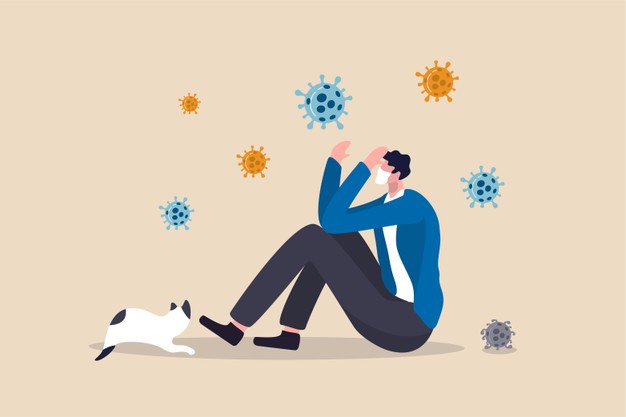
Why Quit Smoking
November 19, 2020
Study Shows Mindfulness Training Reduces Severity of Symptoms of Irritable Bowel Syndrome in Women
December 14, 2020Corona virus disease 2019 (COVID-19) caused by Severe Acute Respiratory Syndrome Corona Virus-2 (SARS-CoV-2) has been declared as public health emergency of international concern by WHO.
Patients with COVID-19 may show clinical clusters of severe respiratory illness manifestations such as fever, non-productive cough, dyspnea (difficulty in breathing), myalgia (pain in muscles), and pneumonia (infection of lung tissue which causes inflammation of air sacs or alveoli. As a result air sacs may fill with fluid or pus, making it difficult to breathe).
SARS-CoV-2 infection can remain asymptomatic or may cause mild symptoms. Severely sick patients may require hospital admission and some of the hospitalized patients may develop Acute Respiratory Distress Syndrome (ARDS), who will require intensive care unit (ICU) treatment. ARDS onset is often progressive and is a life threatening condition. Moreover, ARDS is pivotal component in the development of multiple organ dysfunction and mortality risk.
[ARDS or Acute Respiratory Distress Syndrome in COVID-19 occurs when fluid builds up in the alveoli, tiny, elastic air sacs in the lungs as a result of excessive inflammation. The fluid keeps lung from filling with enough air, which means less oxygen reaches blood stream and deprives organs of oxygen they need to function].
Researchers at a university hospital setting in Spain conducted a pilot study (It is a small scale preliminary study conducted in order to evaluate feasibility, duration, cost, adverse events, and improve upon the study design prior to performance of a full-scale research project). The objective of the study was to identify a strategy which could taper down the severity of COVID-19, or which could be helpful in reducing the morbidity and may be mortality and which could lower the need for limited ICU health care resources.
It has been proposed that vitamin D endocrine system may have a variety of actions on cells and tissues involved in COVID-19 progression especially by decreasing the Acute Respiratory Distress Syndrome.
Vitamin D is a fat soluble vitamin which is now given status of hormone, as it can be synthesized by the body itself, circulates in the blood stream and binds to receptors ( special proteins expressed by various cells) in order to evoke biologic actions.
The vitamin D endocrine system is complex, involving skin, liver, and kidneys for synthesis of vitamin D. (Endocrine system is a chemical messenger system in which chemicals i.e. hormones are released directly into blood stream regulating distant target organs.)
As ultra violet rays from the sun strike our skin they trigger synthesis of vitamin D from cholesterol (a waxy fat like substance). It is naturally present in very few foods and also available as dietary supplements.
Vitamin D obtain from food and sun exposure is biologically inert or inactive. Its activation occurs by hydroxylation (adding of OH group) first in the liver than in kidneys and we get the physiologically active form known as Calcitriol.
Vitamin D plays important role in maintaining healthy bones by regulating calcium and phosphate absorption through the gut.
There are vitamin D receptors and activating enzymes throughout the body i.e. it regulates many vital physiological processes. Studies show that it is involved in modulation of cell growth and numerous cell types of immune system also express receptors for vitamin D i.e. they need vitamin D to function.
Scientists proposed that from a mechanistic perspective there are good reasons to postulate that vitamin D endocrine system favorably modulates host responses to SARS-CoV-2, both in the later hyper inflammatory and early viraemic phases of COVID-19 and may generate beneficial effects in ARDS by:
Decreasing the cytokine/chemokine storm as it regulates immune responses. (Cytokines/chemokines are proteins which are produced by the body during inflammation, which is response of the body against injury. Hyper inflammation or excessive inflammation could damage the body tissues as occurs in case of severe COVID-19.)
Modulating White blood cells or WBCs activity (WBCs help body fight infections).
Maintaining the integrity of pulmonary epithelial barrier (maintaining integrity of inner cells lining of the lungs), stimulating epithelial (inner cells lining) repair, tapering down increased coagulability (decreasing blood clotting).
The participants of the study were 76 consecutive patients hospitalized with COVID-19 infection, with clinical picture of acute respiratory infection, which was confirmed by radiographic pattern of viral pneumonia and by a positive SARS-CoV-2 PCR (a laboratory test used for diagnosing SARS-CoV-2 infection by detection of viral genetic material).
All hospitalized patients received as best available therapy the same standard care (as per hospital protocol). They were given a combination of hydroxychloroquine (400 mg every 12 hour on the first day, and 200 mg every 12 hour for the following 5 days), azithromycin (500 mg orally for 5 days). Calcifediol was also given orally (0.532 mg) to participants for which they were divided into two groups in ratio of 2:1 i.e. 50 patients were treated with calcifediol and 26 did not receive calcifediol on day of admission.
Patients in the calcifediol treatment group continued with oral calcifediol (0.266 mg) on day 3 and day 7, and then weekly until discharge or ICU admission.
[Calcifediol is a pre-hormone form of vitamin D that is produced in liver. As mentioned earlier vitamin D activation occurs first in liver and then in the kidneys. Calcifediol was given to patients for the study in order to bypass the activation stage in the liver].
The results of the study showed that, among the 50 patients who were treated with calcifediol, 1 required admission to ICU (2%), while 26 who were not treated with calcifediol, 13 required admission to ICU (50%).
The group of 50 patients treated with calcifediol, none died, and all were discharged without complications. However, the other group of 26 patients not treated with calcifediol, 13 patients who were not admitted to ICU were discharged, and 13 patients who were admitted to ICU, 2 died and the remaining 11 were discharged.
Through the study researchers concluded that administration of a high dose of calcifediol or 25- hydroxyvitamin D, a main metabolite of vitamin D endocrine system, significantly reduced the need for ICU treatment of patients requiring hospitalization due to COVID-19. Disease severity seems to be reduced by administration of calcifediol but larger trial groups properly matched will be required to show a definitive answer.
REFERENCE:
“Effect of calcifediol treatment and best available therapy versus best available therapy on intensive care unit admission and mortality among patients hospitalized for COVID-19: A pilot randomized clinical study”
http://www.sciencedirect.com/science/article/pii/S0960076020302764






